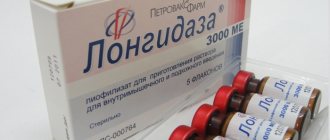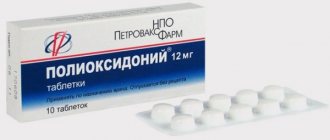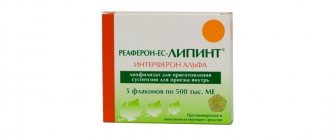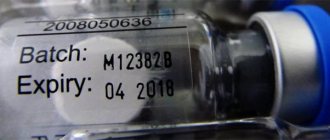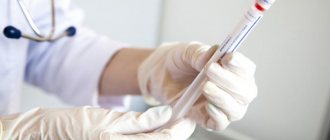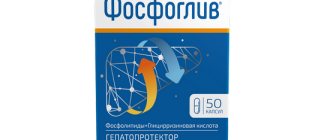From this article you will learn:
- Dysport injections: what is this procedure,
- reviews from cosmetologists, before and after photos,
- how much does Dysport cost per unit (for 2021).
Dysport® is a drug based on botulinum toxin type A, manufactured in the UK. According to the mechanism of action, it is an analogue of the drug Botox®, having exactly the same indications for use, as well as a similar high safety profile. In Russia, the drug is sold in bottles of 300 and 500 units.
In cosmetology, Dysport is most often used to correct dynamic wrinkles in the upper third of the face - “crow’s feet” in the corners of the eyes, longitudinal wrinkles in the forehead, and wrinkles between the eyebrows. Less commonly, the drug is used in the lower part of the face to eliminate vertical lip wrinkles, as well as the so-called “marionette lines” in the corners of the mouth. There are also many other indications, for example, for facial paralysis, bruxism, and hyperhidrosis (excessive sweating).
Two variants of Dysport bottles (300 and 500 units each) –
According to the mechanism of action, Dysport is an analogue of the drug Botox, having exactly the same indications for use. However, the conventional units (IU) of these drugs are not equivalent in strength - studies have shown that 1 IU of Botox is equivalent to approximately 2.5-3 IU of Dysport. This means that if your doctor recommends 30 units of Botox to eliminate forehead wrinkles, then this amount will be equivalent to 3 times more Dysport (i.e. 90 units of the latter).
The cost difference between Botox and Dysport will also be 3 times different. For Dysport, the price for 1 unit is usually only about 100 rubles - while 1 unit of Botox will cost you from 300 rubles. Accordingly, given that Dysport costs 3 times less, but will require 3 times more (compared to Botox), the cost of the procedure with these drugs will be the same. For Botox and Dysport, reviews from cosmetologists and patients will also be similar, and the most important factor is the doctor’s competence.
Dysport: drug characteristics
In table No. 1 below you can see the main characteristics of the drug Dysport - in comparison with other commercial botulinum toxin-based drugs used in cosmetology. As you can see below, Dysport is distinguished from Botox by the lower molecular weight of the toxin molecules, as well as a slightly smaller amount of complexing proteins and human albumin (reducing the protein load reduces the risk of developing an immune response).
Table No. 1 –
A number of scientific studies suggest that the lower molecular weight of the toxin is one of the factors that facilitates the diffusion (spread) of solutions in tissues after injection. However, other factors are also considered important, for example, the injection volume, the protein load of the solution, and the anatomical features of the injection area. In their studies, Cliff S. and Judodihrdjo H. showed that the diffusion value of the Botox solution was lower than that of Dysport (with the same injection volume and equivalent ED content in a 1:3 ratio).
Dilution and storage - provided that it is stored in a refrigerator at 2 to 8 degrees Celsius - the shelf life of Dysport is 1 year. Once diluted, the solution can only be used within 24 hours, during which time it must also be stored in the refrigerator at the above temperature. The diluted solution cannot be frozen, because in this case, ice crystals injure the toxin molecules. For example, studies conducted on Botox have shown that freezing an already diluted solution reduces its effectiveness by approximately 68.9%.
Dysport is diluted with normal saline solution (NaCl). The saline solution used may be pure or contain preservatives. The last option is preferable, because Benzyl alcohol contained among the preservatives has a weak anesthetic effect, making injections less painful. Using 2.5 ml of NaCl solution to dilute a bottle of 300 units allows you to get 12 units of Dysport per 0.1 ml. Using the same amount of saline solution to dilute a 500 unit bottle allows you to get 20 units of Dysport per 0.1 ml.
Table No. 2 –
tip of the nose
The tip of the nose is an important component of its aesthetic appeal. With age, the tip of the nose droops, which emphasizes the convexity of its back. Drooping of the nasal tip in young patients is associated with increased activity of the depressor septum muscle during smiling, which is also often accompanied by shortening of the upper lip. The same phenomenon is observed in those with a prominent nose and an underdeveloped chin.
Before deciding on the introduction of BTA, the length of the patient's upper lip and nasolabial angle is assessed. There are 2 ways to administer injections into the depressing septum nasal muscle: percutaneous and intraoral. The latter method is quite difficult to implement, so we will only consider the method of administering BTA through the skin.
Due to the special sensitivity of the nose to external anesthetics, it is recommended to use ice compresses to reduce pain. BTA insertion points are located on both sides of the nasal septum at the base of the medial crus (Figure 12)
.
The BTA drug is administered superficially in a dosage of 1-2 units. Botox® or 4-6 units. Dysport® for every point. Dosage may vary depending on the desired degree and duration of correction, facial proportions, observed muscle activity and the work of adjacent muscles.
Figure 12. BTA injection points for correction of drooping nasal tip
Complications: In general, complications when correcting drooping nasal tip with BTA preparations are extremely rare. Among the side effects, patients most often name pain. Too much action of toxins on the depressor septum nasalis muscle can lead to ptosis of the upper lip.
Application features of Dysport® –
Published scientific studies show that on average, the onset of the effect occurs within 2-3 days after injections (especially when it comes to repeated administration of botulinum toxin). You will be able to see the final result after the initial course of therapy in approximately 10-12 days. Moreover, the average duration of a pronounced therapeutic effect when using 50 units of dysport is about 85 days, and the maximum duration of a visually noticeable effect is up to 120 days (according to Brandt F., Swanson N., Baumann L., 2008).
Dysport injections are given at specific points. The optimal volume of the drug at one needle insertion point is 0.05 ml, which contains 10 units of the drug. You can use a larger dilution of the drug (for example, 10 units in 0.1 ml - per 1 point of needle insertion) if you want to achieve greater distribution of the solution in the tissues, which may be useful for some indications (24stoma.ru). However, a decrease in the concentration of the toxin in the solution while simultaneously increasing the diffusion of the solution in the tissues will cause a decrease in the duration of the therapeutic effect.
The optimal approach is to remember that injections should not be repeated after only a short period of time if the patient is not satisfied with the severity of the effect achieved. Correction can be done only after 3-4 weeks, by additional administration of minimal doses. In Europe and the USA, a so-called “soft approach” applies to botulinum toxin injections for cosmetic reasons. This means that the doctor recommends that the patient initially administer only minimal doses, while maintaining the natural appearance of the face.
In this case, the patient is scheduled after 3-6 weeks for examination and possible minor correction of the result with additional administration of small doses of botulinum toxin. This approach ensures that you get a compromise that suits you between reducing the number of wrinkles and the natural expression of your face, which will not look like a frozen wax mask. Thus, the calculation of the dose of Dysport will depend not only on the type of facial muscles and their severity, but also on the patient’s expectations (whether he wants to achieve a dramatic effect or a natural one).
Below we will look at the main areas on the face in which you can remove wrinkles with Botox. However, remember that botulinum toxin will only allow you to get rid of dynamic wrinkles in the forehead, bridge of the nose, and in the corners of the eyes, i.e. in the upper third of the face. To simultaneously remove static wrinkles (if any), you will need to combine Botox with other wrinkle correction techniques, for example, dermal fillers, peels or laser skin resurfacing.
→ Dysport: instructions for use (download in PDF)
special instructions
The units of action (AU) of the drug are specific and are not equivalent to those for other drugs that contain botulinum toxin .
The question of the ability to drive a car and perform work that poses a risk to health and life, as well as work that requires a high speed of mental and motor reactions, must be decided only after assessing the patient’s individual response to therapy.
Repeated injections should be administered with caution to persons who have had hypersensitivity reactions to a previous administration of the drug. The risk of hypersensitivity reactions must also be taken into account when assessing the potential benefit of treatment.
myoneural transmission disorders are treated with caution and under the supervision of a physician . In such patients, due to increased sensitivity to botulinum toxin , pronounced muscle weakness may develop.
Dysport injections by zone –
In this article, we focus on botulinum therapy with Dysport specifically for cosmetic purposes, although the drug is widely used in ophthalmology and neurology. Dysport injections containing botulinum toxin type A can remove or reduce the severity of dynamic wrinkles on the face that form as a result of contraction of facial muscles. If it is necessary to simultaneously remove static wrinkles, the use of Dysport is indicated in combination with dermal fillers, peelings or laser skin resurfacing.
Dysport injections: video
1) Wrinkles in the eye area –
Wrinkles around the eyes are formed as a result of a combination of three reasons: 1) as a result of an age-related decrease in the content of collagen and elastin in the skin, 2) photodamage to the skin from ultraviolet radiation, 3) regularly repeated contractions of facial muscles. The main indication for the use of Dysport in this area is the elimination of crow's feet in the corners of the eyes. Nevertheless, with the help of this drug, for example, it is possible to widen the height of a narrow palpebral fissure.
Dysport injections for crow's feet -
Introduction technique - for this zone, 3-4 needle injection points are usually made, located at a distance of 1.-1.5 cm from each other (on each side). If for Botox they usually make 4 injection points, then for Dysport 3 points are enough, but again the decision remains with the doctor. Fewer points with the fact that Dysport tends to spread more strongly in the tissues after injection than Botox. However, the decisive factor here will be the degree of dilution of the drug, and the volume of solution injected into each needle insertion point. If 0.1 ml is injected, then you can limit yourself to 3 points, if 0.05 ml each, you can make 4 points. To identify the points, the patient is usually asked to squint.
The injection sites should be 1-1.5 cm from the edge of the orbit. According to the rules, the direction of needle insertion should be as in Fig. 8. The solution is injected superficially, soft tissues should be relaxed. It is advisable to stretch the skin before injection to see how the superficial blood vessels are located. This will reduce the risk of bleeding. It is important to ensure that all needle insertion points are placed strictly above the cheekbone, because otherwise, drooping of the corner of the mouth may occur. Clinical studies have shown that the optimal dose for eliminating crow's feet is a dosage of 30-36 units of Dysport (equivalent to 12 units of Botox) - on each side for women. For larger men, the dose is usually slightly higher.
2) Dysport injections in the forehead -
Most often, wrinkles on the forehead appear due to regular contractions of the frontalis muscle, for example, when you frequently wrinkle your forehead. Dysport injections can smooth out your wrinkles, making them invisible. In the second large group of patients, constant contraction of the frontal muscle is associated not with facial expressions, but with ptosis of the eyebrows (i.e., their drooping). Such patients unconsciously tense the frontalis muscle to keep their eyebrows raised. As a rule, this group of patients requires not just botulinum toxin injections, but their combination with a surgical eyebrow lifting technique.
Dysport injections on the forehead: video
Administration technique - the number of units required for the procedure will depend on: 1) the area of intervention (wrinkles can be all over the forehead or only in some areas, 2) on the severity of the frontal muscle, 3) the patient’s wishes to obtain either a natural or dramatic result. Of course, it is advisable to explain to the patient that the best option is to try to maintain a small activity of the frontalis muscle and at the same time reduce the severity of wrinkles. In this case, facial expressions will be closer to natural.
The patient is asked to wrinkle his forehead, and the point of needle insertion is determined with a marker (Fig. 10). 6 units of Dysport (equivalent to 2 units of Botox) are injected into each needle injection point - with an injection volume at each point of 0.05 ml. This corresponds to a dilution of 300 units of Dysport in 2.5 ml of saline. For women, a dosage of 75-90 units of Dysport (equivalent to 25-30 units of Botox), distributed over 12-14 needle injection points, is usually sufficient. For men, 90-120 units of Dysport is usually sufficient, which is equivalent to 30-40 units of Botox.
Sometimes, in order to achieve a natural appearance and prevent eyebrow drooping, the procedure is divided into two stages. On the first visit, the main part of the total dose is distributed over the upper 2/3 of the forehead. After 2 weeks, during the second visit, they carefully “work out” the lower part of the forehead, which will ensure that the desired position of the eyebrows is maintained. For Dysport, the price per unit in Moscow will be about 100 rubles, and the final price will depend on the required total number of units.
Complications – after Dysport injections, complications may include a radical change in the shape and position of your eyebrows. For example, the middle third of the eyebrows may drop, causing them to lose their arched shape, and this is very critical for women. But the bend can also become more pronounced due to the lowering of the tips of the eyebrows, and this is already critical for men whose eyebrows usually have a straight shape. Curved eyebrows on a man will look quite funny. Therefore, before making injections, both the patient and the doctor must decide whether the position and shape of the eyebrows need to be changed, and how exactly.
It is very important to take into account the anatomy of the forehead and the location of the eyebrows above the edge of the orbit, because Low-set eyebrows can move down even further. Moreover, in parallel, this can also lead to drooping of the upper eyelids and a decrease in the height of the palpebral fissure. If the patient has low-set eyebrows, it is advisable to inject botulinum toxin only into the upper part of the forehead. Eyebrow drooping can be caused by incorrect choice of needle injection points, or even simply by excessive administration of botulinum toxin units. The risk of complications increases if you use a large volume of solution at each point, because... this will increase the area of distribution of the drug in the tissues.
The main complications with injections in the forehead area are:
- undesirable eyebrow shape,
- drooping eyebrows,
- sagging eyelids,
- no visible effect.
The position of the eyebrows is controlled by the lower part of the frontalis muscle, and therefore it is prohibited to inject botulinum toxin into the area 1 cm above the eyebrows. And in the zone another 1 cm above the first zone - do them with great care, choosing the right number of units, and also use a small injection volume in this zone at each point - preferably 0.05 ml. It is important to warn patients with wrinkles in the lower forehead that they may not be correctable without the additional use of dermal fillers.
It is important to exercise caution especially when working with patients who have low-set eyebrows and/or excess upper eyelid skin. In such patients, an excessive amount of units and incorrect choice of needle injection points can lead to an even greater decrease in the level of the eyebrows and/or sagging of the upper eyelids. Good cosmetologists with excessive development of the skin of the upper eyelids usually recommend that patients first undergo blepharoplasty, and only at the second stage proceed to botulinum toxin injections in the forehead area.
3) Dysport between the eyebrows –
According to FDA recommendations, it is recommended to make 5 needle injection points in the area between the eyebrows - with a total dose of 20 units for Botox, and for Dysport the equivalent amount is 60 units. This dosage is standard for women with moderately developed facial muscles. If the facial muscles are sufficiently pronounced, women may need 28 units of Botox (which corresponds to 80-85 units of Dysport).
At the same time, many well-known authors (for example, Baumann L.) recommend injections only into 3 points: alternately into the lower part of each “corrugator muscle”, as well as into the proud muscle. Baumann recommends injecting 0.1 ml of solution containing 4 to 6 units of Botox (which corresponds to 12-18 units of Dysport) into each of the 3 points.
As for men, in most cases a dosage of 40 units for Botox or 120 units of Dysport is considered sufficient. For very large men with pronounced glabellar muscles, about 60 units of Botox or 180 units of Dysport may be required. However, a number of scientific works show that in the absence of pronounced muscles in the interglabellar area and the need to maintain a natural look in men as well as in women, a minimum dosage of 20 units of Botox / 60 units of Dysport can be used, but in this case the effect of the injections will be less lasting.
Botulinum toxin injections between the eyebrows: before and after video
Complications - injections can lead to a slight rise in the inner and middle part of the eyebrows, which in some cases can be a positive thing (especially with low eyebrows). Provided the doctor has good knowledge of the anatomy of the glabellar complex of the muscles between the eyebrows, complications are quite rare. Otherwise, ptosis of the upper eyelid (drooping) may develop. This usually happens when the doctor has incorrectly determined the injection points or uses a large volume of solution at each point, which will inevitably cause too much diffusion of the solution into the tissues. If ptosis occurs, eye drops with phenylephrine or apraclonidine are prescribed.
Side effects
Common side effects of Dysport, regardless of indication for use, are neuralgic amyotrophy ; irritation, short-term burning sensation (usually disappears within a minute or two after injection), pain and hematoma at the injection site; skin rashes, general weakness, increased fatigue, flu-like symptoms .
With spasticity of the arms in adult patients after a stroke , the following are possible: dysphagia (usually develops when a dose exceeding 2.7 thousand units is administered at one or several points), weakness of the arm muscles. Falls and accidental injuries quite often also become complications of the procedures.
With equinavarus foot deformity, Dysport can cause: weakness of the leg muscles, abnormal gait, urinary incontinence, diarrhea , accidental injury due to a fall.
Abnormal gait and accidental injury may result from excessive muscle weakness. Sometimes they are caused by the spread of the action of botulinum toxin to the muscles located near the injection site, which take part in maintaining the balance of the patient’s body when walking and standing or in a certain motor act.
With spastic torticollis dysphonia , headache, impaired accommodation, diplopia , respiratory disorders, dysphagia , and dry mouth are possible
The severity of dysphagia depends on the dose. The side effect usually develops after injection of the drug into the sternocleidomastoid (“sternocleidomastoid”) muscle. As a rule, this requires following a diet that involves avoiding rough foods (until the unpleasant symptoms completely disappear).
With hemifacial spasm ( facial hemispasm ) and blepharospasm the following phenomena were observed: weakness, paresis of facial muscles, ptosis , lacrimation, dry eyes, diplopia , ophthalmoplegia , entropion and swelling of the eyelid.
Side effects quite often develop when the rules for diluting the drug are violated, the dose is incorrectly selected, the points and depth of administration, and the direction of the needle. Violation of the technique for administering Dysport leads to excessive diffusion of the solution and temporary paralysis of the muscles in the area of drug administration.
Studies have found that in patients with axillary hyperhidrosis
The consequences of using the drug for the correction of wrinkles can be expressed in the form of: swelling of the eyes, a feeling of facial stiffness, dry keratoconjunctivitis , local reactions (including hematoma, pain, itching and skin rashes, erythema , paresthesia ); increased muscle weakness in the area of drug administration (which often leads to asthenopia , ptosis of the eyelids, and sometimes - infrequently - can cause visual disturbances and paresis of the facial muscles), headache, rash, itchy skin, urticaria .
Experience with Dysport has led to the conclusion that side effects are usually moderate and transient. During botulinum therapy with type A neurotoxins, isolated cases of patient death due to pneumopathy , significant asthenia , and dysphagia .
Aspiration pneumonia , swallowing disorders and severe muscle weakness, which can cause death, occur no more often than one in 10 thousand cases.
Digestive disorders, headaches, dizziness and hypersensitivity skin reactions develop quite rarely.
Dysport: unit price (for 2021)
For the drug Dysport, the price per unit in Moscow will average from 100 rubles (in cosmetology clinics in the middle price segment). Accordingly, if it is necessary to make 70 units to eliminate crow's feet in the corners of the eyes, the final cost will be 7,000 rubles. At the same time, in most clinics, the initial examination by a cosmetologist will also be paid, and can cost another 600 to 2000 rubles.
For example, 1 unit of Botox costs patients much more - about 320 rubles, but given that Botox and Dysport units are not equivalent in strength (the proportion between them is 1:3) - 70 Dysport units will be equivalent to approximately 24 Botox units. Thus, when you do Botox, you need 3 times fewer units of botulinum toxin (compared to the drug Dysport) and, accordingly, the final cost of the procedure will be almost the same - no matter which of these drugs you choose.
Interesting information - the purchase price of Dysport for cosmetology clinics is 300 units for each bottle, starting from 12,000 rubles. Thus, the cost of 1 unit of Dysport for the clinic will be about 40 rubles. But even after paying the full price, many patients are faced with the fact that the effect of botulinum toxins is completely absent or weakly expressed. This is due to gross violations committed by the cosmetologist due to incompetence, violations of storage conditions, injection techniques, etc. For a complete list of violations that can lead to this, read the article:
→ Why “Botox doesn’t work”: how we are being deceived
Pharmacodynamics and pharmacokinetics
Dysport is a drug whose pharmacological properties are determined by the activity of the Clostridum botulinum A-type protein toxin that specifically acts on nerve cells .
Botulinum toxin blocks the release of acetylcholine at myoneural synapses (neuromuscular junctions), which leads to the elimination of muscle spasticity in the area of application of the drug.
The conduction of nerve impulses is restored as nerve fibers regenerate and contacts with the postsynaptic motor plaque are restored.
The pharmacokinetic profile of the drug has not been described.
Dysport: what not to do after the procedure
Under no circumstances, both before and after the procedure, should you expose the treated areas of skin to active solar radiation, much less sunbathe (even after applying sunscreen). If you made injections during a period of high solar activity, then in the next two weeks you need to use sunscreen with a high degree of protection, as well as sunglasses and a wide-brimmed hat.
After the procedure, it is important that you do not lie down on the sofa, i.e. Under no circumstances should you take a horizontal position for 4 hours (this is important to reduce the risk of hemorrhages at the injection sites). It is necessary that for the next 2 hours after the procedure you actively contract the muscles of the injection area, i.e. wrinkled their forehead, frowned, etc. Such movements should be done 1-2 times every minute - for 2 hours. This need is due to the fact that in this case the neurotoxin will be able to achieve better binding to acetylcholine receptors.
In addition, please note that Dysport and alcohol are completely incompatible. It is not advisable to drink alcohol 1-2 days before the procedure, as well as for at least 2-3 days after it. If you do Dysport injections repeatedly, then 2-3 days are really enough. If the procedure is primary, then in this case the effect develops more slowly (the final effect may occur only after 10 days), and therefore it is better to avoid drinking alcohol for a slightly longer period.
Important : in order to minimize the risk of hematomas, at least 10 days before Dysport injections, you must stop using aspirin, drugs from the NSAID group, creams with arnica or vitamin K, as well as green tea, vitamin E or any other drugs that can reduce clotting blood.
→ Inexpensive analogues of Botox®
Overdose
The use of Dysport in significant doses can lead to the development of distant and deep neuromuscular paralysis. In some cases, overdose causes an increased risk of neurotoxins entering the systemic circulation and provokes complications associated with the effects observed in food poisoning with botulinum toxins (for example, dysphonia and dysphagia). If taking the drug in high doses leads to paralysis of the respiratory muscles, artificial ventilation of the lungs is necessary. There is no specific antidote. The benefit from using the antitoxin is minimal. The patient should be provided with general supportive care and, if necessary, symptomatic therapy should be prescribed.
Signs of an overdose may appear a certain period of time after the injection. In the event of overdose by injection or accidental oral ingestion, the patient should remain under medical supervision for several weeks to monitor for possible symptoms of increasing muscle weakness or muscle paralysis.

